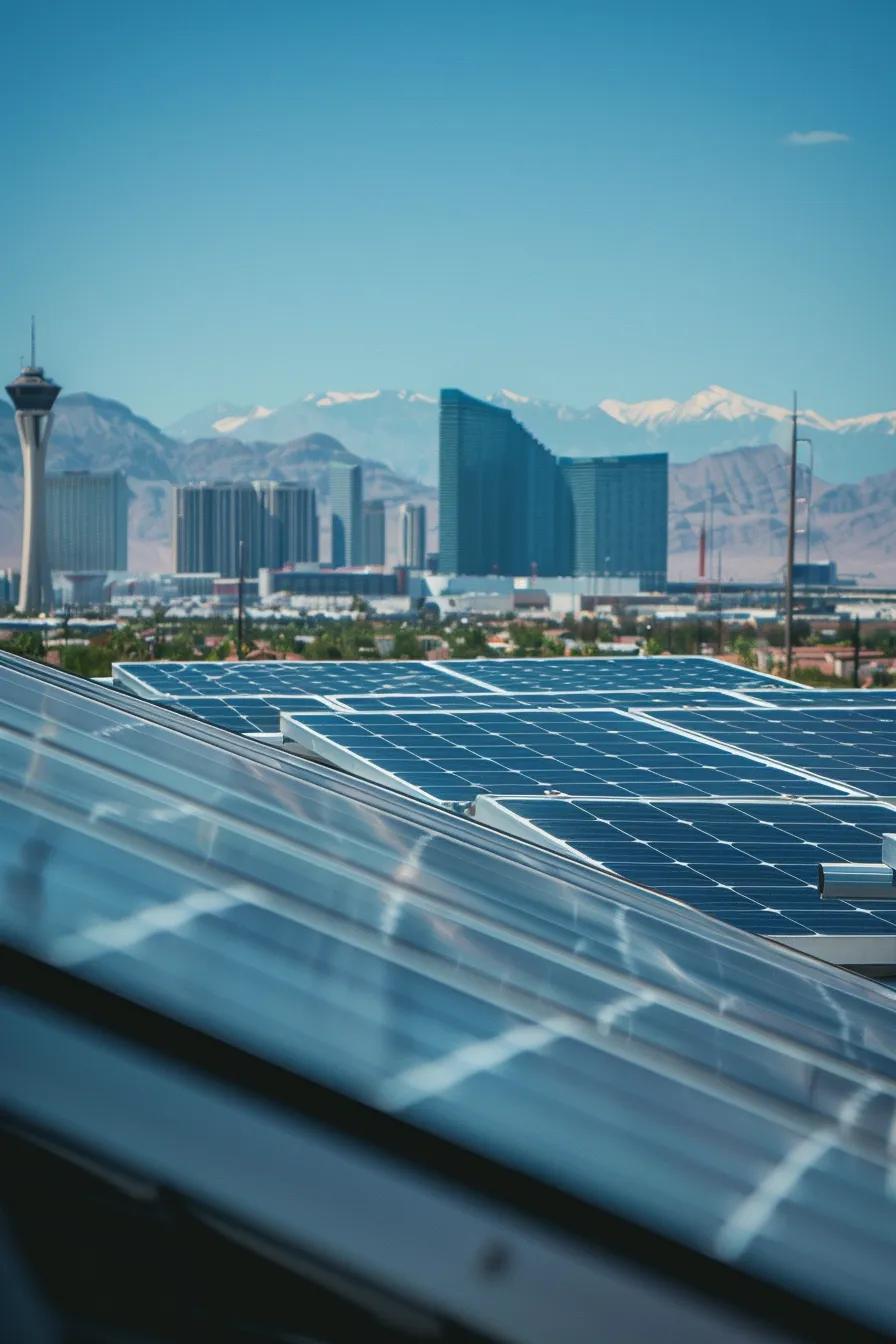
Tailored Solar System Design in Las Vegas: Your Custom Energy Solution
Did you know a custom-designed solar system can boost energy production by up to 30% compared to generic setups? By fine-tuning photovoltaic panels, inverters, and storage to your property’s specific roof, shade patterns, and energy usage, you ensure peak efficiency, significantly lower electricity bills, and greater energy self-reliance.
Maximizing Solar Energy Production – English
Custom solar system design can elevate energy output by up to 30% over standard systems, maximizing energy generation through precisely placed panels and perfectly sized components. This personalized approach minimizes energy loss from shade and component mismatch, increasing your kilowatt-hour production and reducing utility expenses.
Solar Energy Industries Association, “Solar Industry Research Data” (2024)
This research underscores the advantages of custom solar design, highlighting its role in enhancing efficiency and cutting costs.
This guide delves into:
- The primary advantages of custom solar system design
- A detailed engineering process, from initial survey to system activation
- Key differences between residential and commercial solar planning
- Essential system components and advanced technologies
- Nevada-specific financing options and available incentives
- How to select the ideal Las Vegas solar installer
- Answers to frequently asked questions about solar design
Discover how Vegas Solar LLC utilizes local expertise, complimentary consultations, and flexible financing to craft solar energy solutions perfectly aligned with your objectives.
What Are the Advantages of Custom Solar System Design?

Custom solar system design creates a photovoltaic solution meticulously engineered for your property’s dimensions, energy needs, and financial goals, maximizing both energy output and return on investment. By carefully analyzing your roof’s orientation, daily energy consumption, and shading patterns, we develop an optimized layout that enhances panel performance and cost-effectiveness.
Key benefits include:
- Maximized energy generation through custom panel placement
- Shorter payback periods thanks to precise system sizing
- Seamless aesthetic integration with your property’s architecture
- Improved energy resilience with tailored battery storage solutions
- Reduced long-term maintenance through optimal component selection
These advantages pave the way for an efficient installation process that aligns system performance with your long-term energy aspirations.
How Does Custom Design Enhance Energy Efficiency and Savings?
Custom design optimizes energy efficiency by aligning panel orientation, tilt angle, and wiring configuration with your site’s specific solar irradiance patterns. This precise calibration minimizes energy losses from shading and component mismatches, boosting your kilowatt-hour production and significantly lowering utility bills.
Why Is Custom Solar Design Superior to Standard Systems?
Custom systems outperform standard packages because they integrate detailed site-specific data—including roof pitch, local climate conditions, and energy usage trends—into the engineering model. This personalized approach ensures optimal system sizing and component selection, guaranteeing you invest only in the capacity that delivers tangible savings.
How Does Custom Design Contribute to Environmental Goals and Energy Independence?
A custom solar setup reduces your carbon footprint more effectively by capturing maximum sunlight and intelligently directing surplus energy to storage or the grid. This optimized approach fosters greater energy independence, allowing you to rely on clean power during outages or periods of high electricity rates.
What Is the Step-by-Step Process for Designing a Custom Solar System?
Designing a custom solar system involves a structured, four-phase process that transforms site data into a high-performance energy installation.
How Is the Initial Consultation and Site Assessment Performed?
The process kicks off with an on-site evaluation to gather crucial property details, review your energy bills, and identify any shading obstructions. Our technicians assess the roof’s condition, orientation, and electrical infrastructure, creating a detailed digital model to pinpoint the most effective panel placement zones. This comprehensive survey provides an accurate foundation for the entire project’s engineering.
How Do We Determine System Size and Select Components?
Leveraging your energy consumption data and detailed sunlight analysis, our engineers calculate the necessary system capacity and select panels, inverters, and batteries that align with performance targets and your budget.
This comparison illustrates how higher-efficiency monocrystalline panels generate more power per square foot, while polycrystalline options offer a more budget-friendly initial investment without compromising reliability.
How Are Financial Incentives and Payback Periods Incorporated?
Our financial modeling includes the 30% Federal Solar Tax Credit, Nevada’s net metering credits, and available loan or lease programs. By projecting your payback period and return on investment, we clearly demonstrate how incentives reduce your net installation cost and accelerate your savings.
Federal and State Solar Incentives – English
The Investment Tax Credit (ITC) allows homeowners to deduct 30% of eligible solar expenses from their federal tax liability, directly reducing the upfront cost and speeding up the payback period. Nevada also offers net metering programs that credit excess solar generation at the retail rate, maximizing your cost savings throughout the year.
U.S. Department of Energy, “Federal Tax Credit for Solar” (2024)
This citation provides valuable information on the financial incentives available for solar systems, directly relevant to our discussion on financing options.
What Are the Steps for Permitting, Installation, and Activation?
Following engineering approval, we secure the necessary permits from local authorities and utility companies. Our certified installers then expertly mount the panels, configure the inverters, and connect the system to your home’s electrical panel. Final inspections and grid interconnection approval ensure safe and immediate activation, empowering you to start generating clean energy right away.
How Does Residential Solar Panel Design Differ from Commercial Solar Installation Planning?
Residential design typically prioritizes roof aesthetics, space constraints, and homeowner schedules, while commercial planning focuses on larger energy demands, structural load capacities, and uninterrupted business operations. Both require rigorous analysis, but the scale and complexity of the systems vary considerably.
What Are Key Considerations for Residential Solar System Design?
Homeowners often look for seamless integration with their roofline, minimal visual impact, and compatibility with home energy management systems. Our designers carefully assess attic ventilation, breaker panel capacity, and potential shading from nearby trees to optimize each array.
What Unique Challenges Exist in Commercial Solar System Engineering?
Commercial installations must accommodate flat or low-pitch roofs, existing HVAC units, roof load limitations, and the need for business continuity. Engineers design robust racking systems, whether ballasted or penetrating, and plan installations to minimize disruption during business hours.
How Do Roof Types and Energy Consumption Affect Design Choices?
Roof materials, pitch, and age influence the choice of mounting hardware and waterproofing techniques, while your specific energy consumption profile dictates the system size and any necessary battery storage. Analyzing usage patterns allows for precise alignment between energy generation capacity and demand peaks.
What Are the Main Solar System Components and Technologies Used in Custom Designs?
A custom system includes photovoltaic panels, an inverter system, and optional energy storage. Each component plays a critical role in converting sunlight into usable energy, managing the system, and ensuring reliability.
How Do Different Solar Panel Types Compare in Efficiency and Cost?
Solar panels differ in their cell chemistry, efficiency ratings, and warranty terms. Monocrystalline panels offer superior energy output and longevity, while thin-film options provide greater flexibility and lighter weight for specialized applications.
What Are the Options for Solar Inverters and Their Benefits?
Inverters are essential for converting the DC electricity generated by your panels into the AC electricity used in your home and sent to the grid.
- String Inverters: Provide centralized conversion and are a cost-effective choice for uniform solar arrays.
- Microinverters: Optimize energy production at the individual panel level, effectively mitigating shading losses.
- Hybrid Inverters: Seamlessly integrate battery storage, streamlining overall system management.
Each inverter type enhances system performance and reliability based on your specific project priorities.
How Does Battery Storage Enhance Solar Energy Systems?
Battery storage captures surplus solar energy for use during cloudy periods or peak demand times, increasing your self-consumption and overall system resilience. The capacity of the battery is carefully sized to meet your backup power needs and take advantage of time-of-use electricity rates.
What Are Popular Battery Solutions Like Tesla Powerwall and Enphase IQ Battery?
These advanced systems offer integrated energy management, allowing homeowners to monitor and optimize their energy usage in real time.
What Financing Options and Incentives Are Available for Custom Solar Systems in Nevada?

Nevada homeowners and businesses can take advantage of federal, state, and utility programs to reduce net installation costs and improve cash flow.
How Does the Federal Solar Tax Credit (ITC) Reduce Installation Costs?
The Investment Tax Credit allows you to deduct 30% of your eligible solar expenses from your federal tax liability, directly lowering your out-of-pocket expenses and accelerating your system’s payback period.
What Are Nevada’s Net Metering Programs and How Do They Work?
Nevada’s Net Metering program credits you for excess solar energy generated and sent back to the grid at the retail rate, effectively rolling those kilowatt-hours into future billing cycles. This program rewards on-site energy production and maximizes your cost savings year-round.
What Solar Loan and Lease Options Can Help Fund Custom Systems?
Solar loan programs and power purchase agreements (PPAs) make it possible to have turnkey installations with minimal upfront investment. Loans allow you to own the system and benefit from tax incentives, while leases or PPAs offer predictable monthly payments without the responsibilities of ownership.
How Can You Evaluate and Choose the Best Custom Solar Design Provider in Las Vegas?
Selecting the right installer ensures a smooth design and installation process, leading to optimal system performance and long-term satisfaction.
What Expertise and Experience Should a Solar Contractor Have?
Top contractors possess certified installer credentials, a proven portfolio of completed projects, and a deep understanding of local building codes and permitting procedures. Reviewing their Better Business Bureau profile confirms their reputation and reliability; check out the Vegas Solar – Better Business Bureau Profile for independent validation.
Why Is Local Knowledge Important for Custom Solar System Design?
Local expertise ensures that system designs are optimized for Las Vegas’s intense solar irradiance, extreme temperatures, and NV Energy’s specific grid requirements. Our community experience streamlines the permitting process and fine-tunes system layouts for optimal performance under local conditions.
How Do Free Consultations and Customer Support Add Value?
Complimentary consultations provide an opportunity to explore your solar options without any obligation, while ongoing support—from system monitoring to warranty assistance—ensures your system continues to deliver savings and reliability. To schedule your no-obligation design review, please visit our Contact Us page.
What Are Common Questions About Custom Solar System Design?
Property owners often inquire about how designers translate energy usage data into panel layouts, the optimal placement of panels for maximum output, and the value of battery storage. Understanding these factors helps you align system size, placement, and financing with your specific goals.
How Do You Design a Custom Solar System for Your Property?
Designers start by analyzing your historical energy consumption and shading patterns, then create models of the most effective panel configurations to meet those energy needs. This data-driven approach ensures that every installed kilowatt generates maximum value.
What Factors Affect Solar Panel Placement and System Size?
Panel placement depends on roof pitch, azimuth (direction), shading from nearby structures, and local weather patterns. System size is determined by your average daily energy usage, peak demand, and financial objectives, balancing generation capacity with budget constraints.
Can I Integrate Battery Storage with My Custom Solar System?
Absolutely. Battery storage systems, such as the Tesla Powerwall or Enphase IQ Battery, integrate seamlessly with solar arrays to store excess energy. This provides crucial backup power and enhances self-consumption, which is particularly beneficial during grid outages and peak electricity rate periods.
How Long Does It Take to See ROI from a Custom Solar Installation?
A well-designed system in Nevada typically achieves a return on investment within 5–8 years. This timeframe considers the Federal Solar Tax Credit, net metering credits, and any applicable state rebates. Accelerated savings during months with high electricity rates can shorten this period even further.
What Maintenance Is Required for Custom Solar Systems?
Custom solar arrays require minimal upkeep. This includes periodic cleaning to remove dust and debris, annual inspections to ensure wiring and mounting integrity, and checks on inverter performance. Proactive monitoring systems alert you to any performance deviations, helping to maintain long-term efficiency.
Custom solar system design in Las Vegas unlocks superior efficiency, reduced costs, and enhanced independence by meticulously tailoring every component to local conditions and your unique energy profile. From precise site assessments to seamless financing integration and dependable installation, a bespoke approach delivers optimal long-term returns. Contact Vegas Solar LLC today for a complimentary consultation and discover how custom solar can power your home or business for decades to come.
